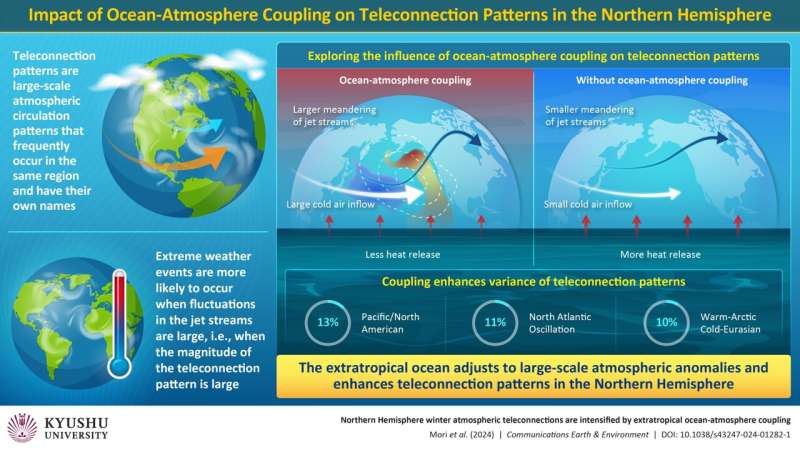This article has been reviewed according to Science X's editorial process and policies. Editors have highlighted the following attributes while ensuring the content's credibility:
fact-checked
peer-reviewed publication
trusted source
proofread
How extratropical ocean-atmosphere interactions can contribute to the variability of jet streams

The interaction between the oceans and the atmosphere plays a vital role in shaping the Earth's climate. Changing sea surface temperatures can heat or cool the atmosphere, and changes in the atmosphere can do the same to the ocean surface. This exchange in energy is known as "ocean-atmosphere coupling."
Now, researchers from Kyushu University have revealed that this ocean-atmosphere coupling enhances teleconnection patterns—when climate conditions change across vast regions of the globe—in the Northern Hemisphere. In their recent study, the team modeled the effect of ocean coupling on atmospheric circulation patterns, finding that extratropical ocean-atmosphere coupling causes more meandering jet streams, which are linked to extreme weather events.
Ocean-atmosphere coupling is most powerful in the tropics, where the coupling is responsible for the well-known "El Niño-Southern Oscillation" in the equatorial Pacific Ocean. The El Niño-Southern Oscillation, in turn, remotely leads to a meandering jet stream in the mid-latitudes through the formation of large-scale atmospheric circulation patterns, i.e., teleconnection patterns.
Outside the tropics, in the mid-latitudes, the impact of ocean-atmosphere coupling on teleconnection patterns is less understood. Nevertheless, its significance in the cause of extreme weather events cannot be ignored, especially in the eye of the climate crisis.
In a study published in the journal Communications Earth & Environment, a team of researchers led by Assistant Professor Masato Mori from Kyushu University's Research Institute for Applied Mechanics, in collaboration with the University of Tokyo, Toyama University, and the Japan Agency for Marine-Earth Science and Technology, shed new light on the phenomenon.
"Because extreme weather events are more likely to occur when fluctuations in the jet streams are large—as in when the magnitude of the teleconnection pattern is large—it is important to understand the mechanisms that form and maintain said teleconnection pattern," explains Mori.
To investigate the role of the extratropical ocean-atmosphere coupling, the researchers conducted two simulations: a coupled run, which considered the interaction between the extratropical ocean and the atmosphere, and an uncoupled run, which neglected the interaction between the two components.
The simulations examined the impact of ocean-atmosphere coupling on teleconnection patterns during the Northern Hemisphere's wintertime: December to February. The effect of the coupling on atmospheric circulation patterns was evaluated through atmospheric variables, such as air pressure and temperature.
In their simulations, the researchers observed significant changes in the atmospheric variables, especially in the North Pacific, subpolar North Atlantic, and northern Eurasia around the Barents-Kara Sea regions off the coast of Siberia. These changes indicated shifts in teleconnection patterns compared to simulations without such an interaction.
"Extratropical coupling selectively enhances the variance of three principal modes of variability, explaining 13%, 11%, and 10% of the total variance of Pacific/North American, North Atlantic Oscillation, and Warm-Arctic Cold-Eurasian patterns, respectively," says Mori.
In the coupled run, heat exchange between the ocean and the atmosphere reduced the air-sea thermal difference. As a result, less heat is released from the oceans and into the atmosphere, leading to increased kinetic energy and a more meandering jet stream. Conversely, when the oceans are uncoupled, the sea surface temperature does not respond to atmospheric fluctuations. The larger temperature differences cause more heat to be released, resulting in a less meandering jet stream.
"The present study quantifies the coupling effect based on large ensemble simulations of a state-of-the-art fully coupled model. Moreover, it reveals how coupling selectively enhances multiple principal modes of variability, not only thermodynamically but also dynamically," concludes Mori.
Notably, the researchers point out that the simulation could have underestimated the coupling effect owing to model bias and issues with simulation design. Nevertheless, new knowledge on the effects of ocean-atmosphere coupling in the Northern Hemisphere could contribute to improving climate projections in the face of the climate crisis through the improvement of climate models.
More information: Masato Mori et al, Northern Hemisphere winter atmospheric teleconnections are intensified by extratropical ocean-atmosphere coupling, Communications Earth & Environment (2024). DOI: 10.1038/s43247-024-01282-1
Journal information: Communications Earth & Environment
Provided by Kyushu University




















